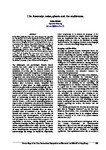The Anomaly: noise, ghosts and the multiverse
| dc.contributor.author | Grant, Jane | |
| dc.date.accessioned | 2017-10-25T11:20:14Z | |
| dc.date.available | 2017-10-25T11:20:14Z | |
| dc.date.issued | 2016-05-01 | |
| dc.identifier.uri | http://hdl.handle.net/10026.1/10094 | |
| dc.description.abstract |
In his 1999 publication “The Life of the Cosmos” the physicist Lee Smolin puts forward the hypothesis that black holes born from dead stars may spawn new universes [1]. He describes these new or “daughter universes” as having retained a trace or a memory of the universe from which they were born [2]. At his recent talk (2015) “Personal knowledge: embodied, extended or animate?” at Plymouth University, the anthropologist Professor Tim Ingold was asked “What is imagination?” His answer in short was that imagination may be some kind of longing. For some years now, I have been working with ideas of longing and science fiction, the inhabitation via imagination of other worlds, whether terrestrial or cosmological. In this article I will address aspects of longing in relation to memory, science fiction and the imaginary. | |
| dc.language.iso | en | |
| dc.title | The Anomaly: noise, ghosts and the multiverse | |
| dc.type | conference | |
| plymouth.journal | ISEA Hong Kong 2016 | |
| plymouth.organisational-group | /Plymouth | |
| plymouth.organisational-group | /Plymouth/Faculty of Arts, Humanities and Business | |
| plymouth.organisational-group | /Plymouth/REF 2021 Researchers by UoA | |
| plymouth.organisational-group | /Plymouth/REF 2021 Researchers by UoA/UoA32 Art and Design: History, Practice and Theory | |
| plymouth.organisational-group | /Plymouth/Users by role | |
| plymouth.organisational-group | /Plymouth/Users by role/Academics | |
| dcterms.dateAccepted | 2016-05-01 | |
| dc.rights.embargoperiod | Not known | |
| rioxxterms.licenseref.uri | http://www.rioxx.net/licenses/all-rights-reserved | |
| rioxxterms.licenseref.startdate | 2016-05-01 | |
| rioxxterms.type | Conference Paper/Proceeding/Abstract |


